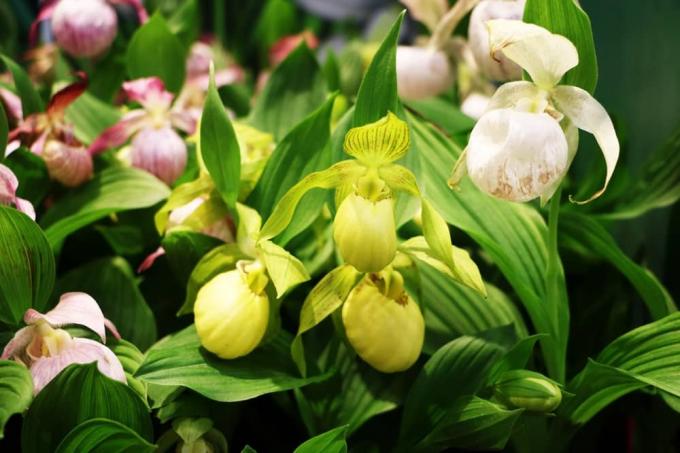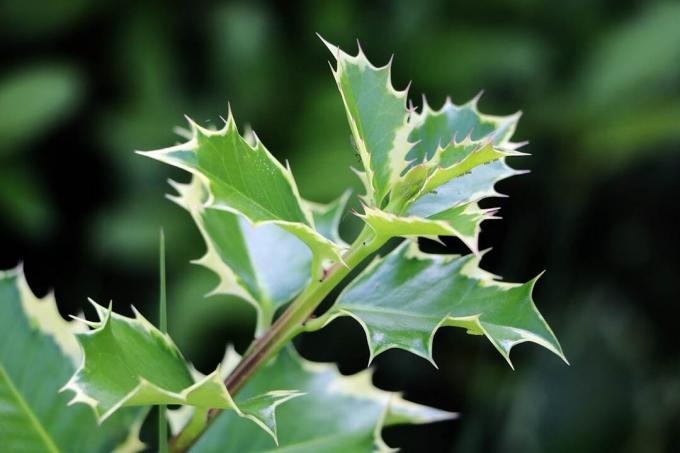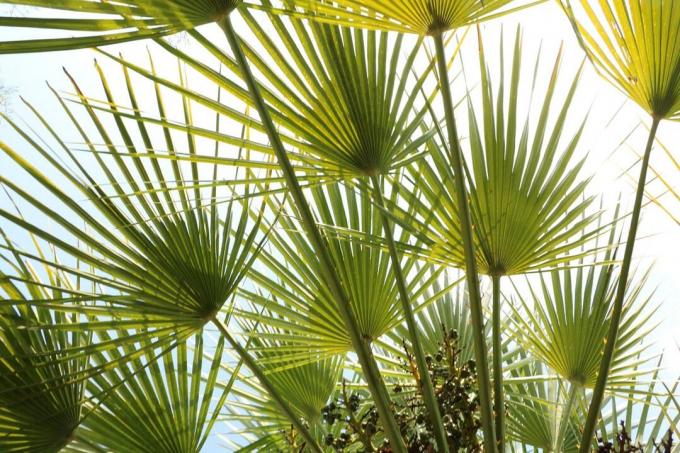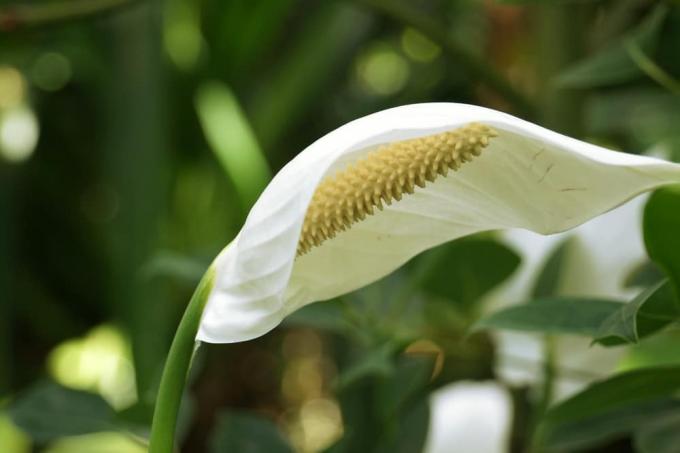

Table of contents
- species
- Location
- Floor
- planting
- Care
- hibernate
They are real gems and an ornament for every garden - outdoor orchids. So it's no wonder that they've become very popular. However, some people shy away from the fascinating plants because they fear that they would be a lot of work and require special knowledge. Of course, this fear is absolutely unfounded. On the contrary: outdoor orchids are extremely easy to care for - provided you follow a few basic rules.
species
When talking about outdoor orchids, this always refers to orchid species that can also be found in the wild in nature in this country. That's around 60, after all. So if you dream of cultivating a tropical orchid species in your garden, you are doomed to failure, as the plant would not be able to cope with our climatic conditions. The situation is quite different with the domestic or northern European species. They are even hardy. However, one should be careful not to simply dig up wild orchids in nature and then plant them in the garden.
That would be at least one administrative offence, as the plants, which have meanwhile become very rare, are under species protection. They must therefore not be dug up, cut off, picked or damaged in the wild. If you do it, you face a hefty fine. Outdoor orchids for your own garden must therefore be bought in specialist shops and should have proof of origin. This evidence proves that these are special breeds that are based on the orchid species that grow wild in our country, but have not been taken directly from nature. The following breeds are very popular:
- Cypripedium (lady's slipper)
- Dactylorhiza (Orchid)
- Epipactis (Stellywort)
- Pleione (mountain orchids)
- Aceras anthropophorum (Onhorn)
- Bletilla striata (Japanese orchid)
- Orchis purpurea (purple orchid)
All of these orchid species are so-called terrestrial orchids. So they are actually planted in soil and don't need any special substrate to thrive. The most popular and most widespread is certainly the lady's slipper.
Tip:
Fascinating species such as the Japanese orchid are usually very difficult to obtain in specialist shops. If they are offered anyway, you should definitely secure several copies at the same time.
Location

So that the cultivation of outdoor orchids in the garden is really successful, the right location is particularly important. The choice of location is therefore the all-important aspect. It is best to think very carefully in advance as to whether the necessary location characteristics can really be met. This not only saves costs, but usually also bitter disappointments. The right location for outdoor or Terrestrial orchids must meet the following criteria:
- it should be in partial shade
- it should only have moderate sun exposure
- it should not be exposed to the midday sun
- it should be protected from excessive wind and rain
A notice:
Some orchid species such as Bletilla striata or Epipactis tolerate full sun if necessary location, but you are definitely on the safe side with a partially shaded spot Page.
Outdoor orchids are often cultivated in the garden in the company of so-called companion plants. Especially those that form a rather light wood are ideal. However, it is important that the orchid still gets enough light despite the companion plants. The perfect location would therefore be on the north side of such a light tree, because the orchid is then usually protected to some extent from heavy rain or even hail.
Floor
As previously mentioned, outdoor orchids do not require any special substrate in which to thrive. They are therefore simply planted in the existing garden soil. However, this does not mean that the orchid will thrive equally well in any soil. Outdoor orchids usually prefer calcareous soils, which should also have a high pH value. Orchids are therefore lime-loving. The pH value of a so-called neutral soil is 6.5. In the case of orchids, it should always be higher.
Tip:
With so-called indicator sticks, which can be bought in specialist shops, the pH value of a soil can be determined very easily.
In order to increase the pH value for the orchid, it is advisable to add unfertilized garden lime to the soil at the planting site. It is also advisable to add limestone, as this can also achieve a longer-lasting effect. In addition, the soil should be exceptionally well drained. Orchids generally like it moist, but under no circumstances tolerate waterlogging. This is usually not a problem with sandy soils. However, if the soil is very loamy, plenty of coarse sand must be mixed in where the plant is located.
A notice:
Under no circumstances should the soil for outdoor orchids be enriched with compost, as this can quickly lead to over-fertilization, which would definitely damage the plant.
planting
Once the soil has been prepared accordingly and, above all, the lime content has been increased, the commercially purchased orchid can be planted. The ideal time for this is either spring (April to May) or early autumn (September to October). When planting, a pit with a depth of about 40 centimeters is first dug. A drainage of about 15 centimeters made of gravel or very coarse expanded clay is then laid in the pit. In order to ensure an additional increase in the lime content, it is advisable to add limestone to the drainage.
The drainage is then followed by an approximately 25 to 30 centimeter thick layer of prepared soil. Finally, the plant is also used in this soil. The tips of the shoots should be just covered with soil. However, the earth must not be pressed tightly, but must remain loose. Finally, there is a covering of beech leaves or, even better, fine expanded clay gravel, no more than two centimeters thick.
Care

Even if something else is often claimed - outdoor orchids are extremely undemanding and therefore relatively easy to care for. In any case, the effort required for maintenance is limited. In principle, only regular watering is required. The following applies:
- regularly check the soil around the plant
- make sure that the soil is always moist or slightly swampy
- use a watering indicator if necessary
- water if necessary
- avoid waterlogging at all costs
- use calcareous water
Opinions have been divided for many years on the question of whether outdoor orchids need to be fertilized or not. Basically, it is better to fertilize too little than too much. Fertilization is not necessary in the first two years after planting. In the following years, it is important to pay attention to how the plant develops. If it doesn't want to grow properly, add some liquid fertilizer to the irrigation water. There are special fertilizers on the market that are tailored to the needs of outdoor orchids. Alternatively, fertilizers for indoor orchids and flowering plants can also be used. Then, however, you should limit yourself to a quarter of the specified amount.
A notice:
Outdoor orchids do not need pruning. They also thrive without pruning in the right conditions.
hibernate
outdoor or Terrestrial orchids from our latitudes are generally hardy. They therefore do not have to be overwintered and taken out of the ground. The plants easily survive frosts, some species even withstand temperatures of up to minus 20 degrees Celsius. Other species, on the other hand, are a little more sensitive. To be on the safe side, the plants should therefore be well covered with fir branches or leaves during the winter months. They may all be hardy, but a warm protective layer is still good for them. Of course, this also applies to snow, which hopefully will cover them well in winter.
 garden editorial
garden editorial I write about everything that interests me in my garden.
Learn more about Exotic Plants

Holly, holly: care from A to Z
The European holly is one of the evergreen plants. It reaches a height of up to five meters and is ideal as a Christmas decoration or garden shrub. The native, although rarely occurring plant is the only native representative of the Ilex family and is particularly easy to care for and robust.

Dwarf palm, Chamaerops humilis: care instructions
The dwarf palm remains small enough that it can also be cared for in the room. However, it also cuts a fine figure in the garden. You can find out here how it is maintained and what needs to be considered.

Dwarf date palm, Phoenix roebelenii: Care from A-Z
The dwarf date palm (Phoenix roebelenii) is a particularly small, actually the smallest palm species of its genus. But that doesn't make them any less decorative. It is the most filigree and elegant date palm and hardly grows higher than one meter.

Growing vanilla plants: 11 tips for care
The vanilla plant is truly exotic in Central Europe and cannot be found in every garden. Vanilla planifolia forms the aromatic pods for which the plant is known. The cultivation of a vanilla plant is easily possible with the right care tips.

Kangaroo Paw: Caring for the kangaroo plant
Kangaroo paws are exotic plants native to southwestern Australia. Considering the care instructions, Kangaroo Paw can also thrive in Central European conditions. Maintenance requires a little more effort. If the plant gets enough attention, it will thank you with magnificent inflorescences.

Einblatt, Spathiphyllum: care from A to Z
Because of simple! The single sheet draws everyone's attention with its extravagant appearance. The imposing flower gives sophisticated rooms that certain something. If the houseplant is in the right place, hardly any care is required. The breeder can find out here what demands Spathiphyllum places on their location.



